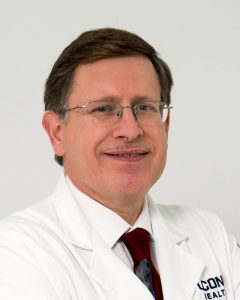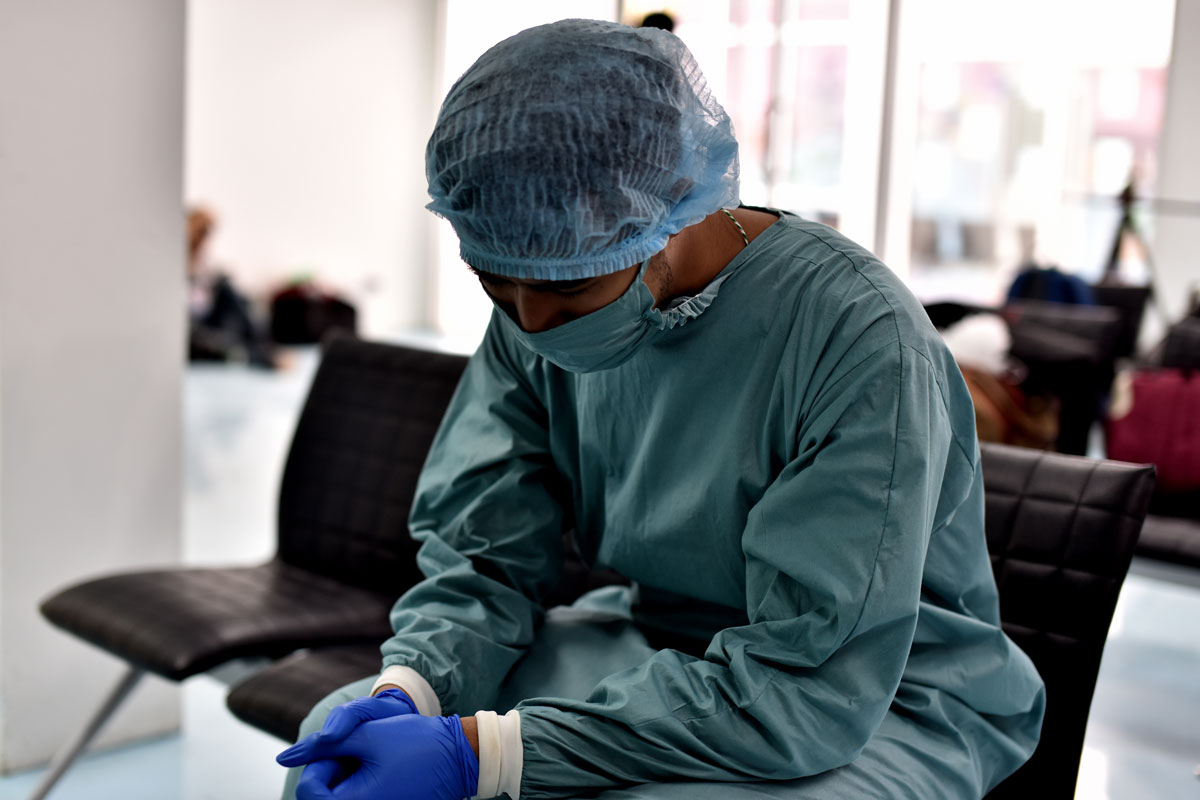Burnout is a real concern in health care, especially during a public health crisis of still-unknown scope and duration. Three UConn Health experts share their observations on the ongoing COVID-19 pandemic’s strain on the health care system, and how it can impact the providers on the front lines.
Alyssa Ciullo is one of those front-line providers. She’s an assistant nurse manager on the medical unit on the third floor of the UConn John Dempsey Hospital, where she’s worked in various nursing roles since joining UConn Health in 2013.
Dr. Jacqueline “Kiki” Nissen is senior associate dean for faculty affairs and associate dean for graduate medical education in the UConn School of Medicine.
Dr. L. John Greenfield is chair of the UConn Health Department of Neurology and has been studying physician burnout.
How does a public health crisis such as this impact an already demanding profession?
Nissen: Coronavirus affects your interpretation of life and also your physical nature by changing how you react around other people and the way you interact with your surrounding environment. When physicians are trained to practice evidence-based medicine and yet the rules, the understanding, the outcomes are changing daily, it’s hard to feel comfort in communicating health care plans to your patients. Uncertainty is never comforting.
Greenfield: Public health crises like the COVID-19 pandemic create severe new stresses on health care providers. The main sources of additional stress are the unknown and the loss of control. We don’t know how to plan for the future when we have no idea how long the crisis will continue. We need to have contingency plans for coverage of essential services if some or many of our providers become ill. This can sometimes seem overwhelming for physicians, nurses, and other health care providers on the front lines treating worried patients and their families.
Ciullo: It’s something we’re just trying to figure out still. We’re constantly trying to figure out what we’re able to safely reuse so we can limit the amount of PPE [personal protective equipment] we’re using. We’re constantly trying to come up with different plans, or what if we did it this way? Does that help? Is there a better way to do anything we’re doing? Looking at how other areas have done it, researching what worked elsewhere, there’s always something to be figured out, so we’re kind of always “on.”

What other, perhaps less obvious, factors are they dealing with?
Greenfield: The social isolation that everyone is experiencing in an effort to control spread of the virus takes its toll on health care providers as well as the general public. Our families are also cooped up with no school, no public activities, and little social contact. The cratering economy can be a major source of stress for young physicians entering the workforce with huge debt from medical school, and older physicians nearing retirement whose savings have been affected. We worry for elderly parents who might be susceptible to the disease.
Nissen: There are the obvious social consequences due to social isolation, but as important are the economic and political consequences that are 24/7 in the media. Watching the news to get caught up can lead to severe anxiety and stress as we navigate through the various reports that come through daily.
How can health care providers support each other during a situation like this?
Ciullo: I don’t know if there’s something specific. We’re all worried, we’re all nervous, we’re all hesitant, but we all do it together. You’ve got to keep the mood up. You really do. You’ve got to stay light-hearted and joking, otherwise it’s too much. One thing that helps is knowing people support you. Our EMTs, our police officers, our firefighters, we’re all in the same struggle, it’s a constant stress on all of us. I think if people recognize you’re going through that – that and a simple “Keep it up” – it goes a long way.
Greenfield: Health care providers need to show their support for each other even when interpersonal contact is not possible. Fortunately, young physicians, nurses, and other health care providers are quite adept at communication by text messaging and other forms of communication that do not require direct personal contact. It is important to reach out to those who may be more vulnerable to the illness or the stress of caring for patients under these circumstances and offer assistance and support. Volunteering to help out when staffing is short, or to cover basic needs like shopping for those unable to get out due to being quarantined, can provide enormous relief to those who are having difficulty coping with the crisis.
Nissen: Reach out to family, friends, colleagues and your favorite community groups for social contact. Call, FaceTime, Zoom, Skype, or try Google Hangouts to reduce your isolation. Meaningful and fun connection, emotional support, and healthy problem-solving are vital to your health and well-being. Action is one of the best treatments for anxiety. Share your concerns and problem solve with colleagues, family and friends to plan coping steps.
Watching the news to get caught up can lead to severe anxiety and stress as we navigate through the various reports that come through daily. — Dr. Jacqueline Nissen
What kinds of things should providers watch for in themselves or their colleagues to avoid going down the path to burnout?
Nissen: Increased demand for care, social distancing, and other unique stressors will test our flexibility and adaptability. We will all have to practice outside of the box – especially when things go wrong and are chaotic. It’s OK – ask for support, evaluate, modify and move forward.
Ciullo: In general, for anyone in health care, when you just don’t see the joy in anything anymore, you hit a point where, “This just sucks. Everything sucks.” And you just need to reach out to your people. We all need to just stick together.
Greenfield: If you feel yourself getting burned out, it is important to let someone know about it and seek help. If you see someone else looking burned out, say something! Providers should be aware of their responsibility to care for their own personal safety, and ensure that they are careful with hand washing and appropriate use of personal protective equipment. They also need to watch for signs of burnout, including depression, despair, irritability, treating patients like “cases” or “numbers” rather than people, and loss of a sense of personal achievement. If providers start to notice these signs, they need to ask for help.
What are some self-care recommendations that may mitigate the stress and other complications that come with an ongoing public health crisis?
Greenfield: It is important to have downtime that you can devote to your own self-care. Get adequate sleep and exercise. Practice mindfulness, and treat yourself to things you enjoy. Take walks and spend time in nature. Cultivate a positive attitude. Listen to music you enjoy. Talk with family and friends. If you are not coping, seek help from friends or professionals.
Nissen: As stress and demands increase, our health habits often take a hit. Bring your meals to work to maximize healthy eating, limit alcohol and THC use, prioritize exercise and get some sunlight! Keep moving – aerobic exercise is vital for stress reduction. Consider walking, biking, running and hiking, throwing a Frisbee or ball as well as exercise and yoga videos. A short aerobic walk or workout is better than nothing! Meaningful and fun connection, emotional support and healthy problem solving are vital to your health and well-being. Consider joining another family or friend for a meal by social media to reduce isolation for everyone.

How long does it/can it take to recover from ongoing stressful/demanding situations or provider burnout?
Greenfield: Recovery from burnout does not follow a predictable timeline, and differs for everyone. It may depend on whether this is purely situational or if you might be prone to depression even without the additional stress. Recovery is an active process, and may take ongoing effort and help from professionals.
Can something like this have the opposite effect of burnout, as in, times like this are the reason people got into health care?
Nissen: This type of pandemic can enhance stress and anxiety in the health care community, as well as enhance the community toward working to the goal of caring for those in need. We cannot predict what impact it will have on physicians and nursing, but we must remain aware and understanding of both avenues. One way to help navigate during uncertain times is to enhance our efforts to communicate about the disease and for leadership to remain calm.
Greenfield: For some health care providers, these challenges may be overwhelming, but for others with more resilience, they can inspire greater efforts to come up with creative solutions to the problems this epidemic has created. Most health care providers entered the field because they want to make a positive difference for their patients, and challenges like the COVID-19 pandemic can spark renewed interest in medicine and reinvigorate some clinicians to join the fight against the virus. Some older physicians have come out of retirement to answer calls for help in this crisis. The surge of creativity is obvious in social media, with so many innovative ideas, humor, and constructive solutions like making facemasks, blogs that exchange information about how to treat COVID-19 patients, and sharing of coping mechanisms. These remind us that we are all in this together, and will get through it together.



